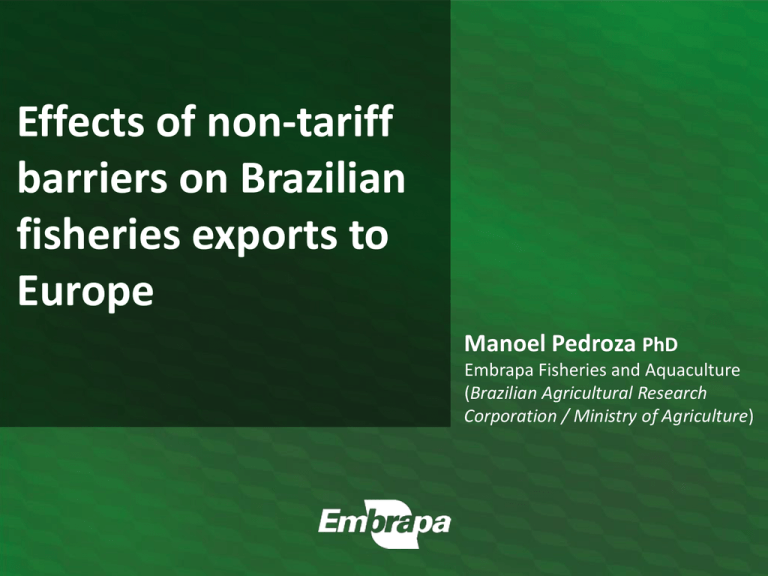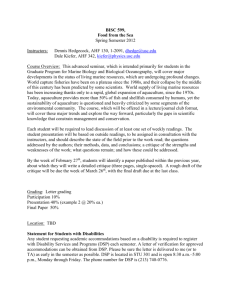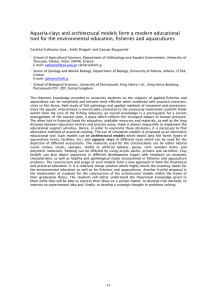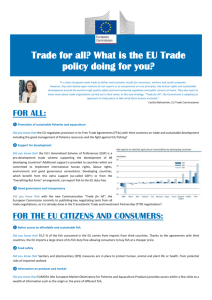Effects of non-tariff barriers on Brazilian fisheries exports to Europe
advertisement

Effects of non-tariff barriers on Brazilian fisheries exports to Europe Manoel Pedroza PhD Embrapa Fisheries and Aquaculture (Brazilian Agricultural Research Corporation / Ministry of Agriculture) Context Development of aquaculture in Brazil Potential for exports Impacts of non-tariff barriers (NTBs) Potential of Brazilian seafood industry On offer... 8,500 Km of marine coast; 12% of total world fresh water; 5.5 million ha of flooded areas, mainly hydroelectric plant reservoirs Up to 1% (55,000 ha) available for aquaculture And on demand... Increasing fish per capita consumption 6.8 kg in 2002 to 9.7 kg in 2010 Large population 200 millions inhabitants; Brazilian fisheries and aquaculture production 1990-2011 1,600,000 1.434.000 Production (tonnes) 1,400,000 1,200,000 1,000,000 800,000 600,000 400,000 Annual production increased by 31% from 2008 to 2011 200,000 0 Aquicultura Aquaculture Pesca Extrativa Capture fisheries Source: Brazilian Ministry of Fisheries and Aquaculture 2012. Total Total 19 aquaculture parks implanted and in implantation on hydroelectric plant reservoirs Per capita consumption of meat in Brazil Brazil is among world 5 big meat consumers (Source: USDA) Fish: greater increase in consumption from 2006 to 2010 Fish Pescado 50.00 45.00 40.00 35.00 30.00 25.00 20.00 15.00 10.00 5.00 0.00 43.30 35.80 Beef Cattle Bovinos 41.70 37.40 Pork Suínos Poultry Aves 39.00 38.60 36.60 35.60 13.00 12.80 13.10 13.40 7.28 7.71 8.36 9.03 2006 2007 2008 Source: : Ministry of Fisheries and Aquaculture and Ministry of Agriculture. 2009 43.90 37.20 23% - 14% 8% 14.00 9.75 2010 34% US$ US$ International trade of seafood in Brazil Deficit: US$ 991 million Source: Brazilian Ministry of Development, Industry and Commerce Emergence of BNTs in the international seafood market Delocalization of world aquaculture production from developed to developing countries Increase of exports from developing countries Increase of BNTs related to reduction of tariffs as protection measures World aquaculture production (thousand tonnes) and share of world production (%) 2000 EU (28) North America Japan China Africa Latin America Total World 2012 1.400 1.260 4,3 1,9 584 593 1,8 0,9 763 633 2,3 1,0 21.522 41.108 66,4 61,7 400 1.485 1,2 2,2 799 2.565 2,5 3,8 32.417 66.633 Source: FAO Application of BNT on fisheries exports from developing countries Kenya (1998): EU banned chilled fish importations declaring poor sanitary standards Fiji (2008): EU banned all importations of fisheries due to problems on production and to the lack of information Vietnam (2004): USA applied technical barriers related to sanitary issues on Pangasius production Methods Inventory-based approach Annual series of export values, between 1990 and 2010, were analyzed in order to identify the NTBs effects. Five more important groups of seafood Fresh or chilled fish , Frozen fish, Fish Filet, Crustaceans, Molluscs European market 21% of Brazilian seafood exports Results Intervention analysis of the NTBs of UE on Brazilian seafood exports ARIMA NTBs had negative impact just for fresh fish Since fresh fish accounts just 14% of Brazilian seafood exports to Europe, NTBs don´t have relevant effects on reduction of total exports; Even for fresh fish, other factors may have determined exports reduction exchange rate between US$ X BR$ international competition increase on domestic demand of Brazilian market Conclusion Public policies need focuses on internal weakness of Brazilian aquaculture High transaction and production costs - No efficient logistics - Difficult to obtain environmental licenses - Low productivity Limitations in terms of scale - Dispersion on production and need to consolidate volume by cooperatives ... But BNTs can be a problem in the future Thank you! Obrigado! manoel.pedroza@embrapa.br





